The company name is often mispronounced as Lah-mah, though the proper pronunciation is Yah-mah, which means “fire” in Spanish. Various “Spanish Ruby” pistols, purchased by the French army during the first World War at a rate of up to 30,000 per month, gave the company its beginning. The pistol was modest, but the total number produced was impressive.
When the company was prosperous, its main source of prosperity was a line of pistols resembling the Colt 1911A1. Most were chambered for the 9mm Luger or 9mm Largo cartridge, but those intended for sale in the U.S. were chambered for the .38 Super or .45 ACP. Over the years, the Llama was produced in some variations that appeared to be nearly identical to the 1911 Government Model, but differed maddeningly and significantly.
Over the years, the quality of the Llama has varied from what I would call indifferent to absolutely dismal. In my opinion, the Llama is best suited as a beginning or entry-level pistol for the owner who wants to see what a 1911 is like, but who cannot afford a better piece. While the pistol can be made serviceable, my guess is that most were meant to be dropped on our shores among the unwary.
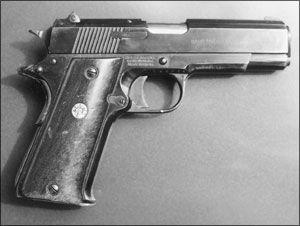
This is strange for several reasons. Spanish gunmakers certainly know how to make a good pistol. The various Stars have proven reliable, the CETME is a great rifle, and the single Ruby in my collection is a well-made and reliable if somewhat “utilitarian” pistol. Still, the Llama has allowed shooters to scope out the 1911 system on the cheap, and has certainly helped gunsmiths to stay in business.
Providing work for gunsmiths is a good thing, of course, but I suspect that few owners of this marginal handgun will be willing to pay a high tariff for repairs and improvements to a Llama. Oddly enough, I once fitted a six-inch Clark Custom barrel and other accessories to a Llama .45 for a fellow just beginning in competition. He used the Llama for a year or so before moving on to something better.
Despite its shortcomings, we should all be familiar with the Llama. In this article, I’ll focus on what is similar to the 1911 and what isn’t, as well as some of the common problems and simple solutions.
The Llama 1911 Basics
First, the basic design is very much John Browning’s locked-breech single-action pistol. The Llama uses a pivoting barrel with a link identical to the 1911 in some regards. However, some will be found with non-removable links. The link pin is sealed in the slot. This means that some drilling and the making of a link pin would be required if the link and/or pin is broken. Most 9mms will have a Colt-like link, but the .45s may have either type. The barrel bushing is also like that of the 1911. Disassembly is straightforward, and in the 1911 style.
The Llama’s firing mechanism differs considerably in detail from the 1911. The slide is the main area of interest. For illustration purposes, I chose a rather common Commander-length Llama in 9mm Luger. This pistol is a true compact, however, rather than a short slide on a full-length frame. The extractor is of the external type. There is no extractor tunnel in the slide and no firing-pin stop. While the elimination of the firing-pin stop and internal extractor may seem a good thing, if the treatment is not of high quality, then we have a problem.
I’ve personally never seen a broken firing pin in a Llama pistol, but my friends in the gun-parts business have sold quite a few. On the other hand, I have repaired numerous extractors. The steel seems quite soft and new replacements are not easy to come by (though Gun Parts Corporation and Bob’s Gun Shop are places to start looking). I have recut and reshaped these extractors, sometimes convincing the part to last for a time.
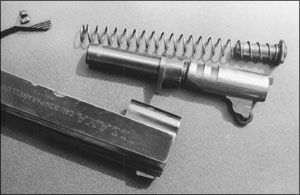
Let’s attack the slide first. As I mentioned, the barrel bushing of the 9mm type pistol is quite like the 1911. The extractor is much different. The extractor is held in the pistol by a roll pin. To remove the extractor, the roll pin is punched out and the extractor simply pushed out. To repair the extractor, the extractor hook is carefully refilled and resharpened. I believe the most common cause of failure in the 1911-type pistol is that some shooters will drop the slide on a loaded chamber.
The extractor is designed to work in a controlled feed manner, picking up a round from the magazine and feeding this cartridge into the chamber. When the extractor is forced to make a jump over a case rim, it stretches the extractor and can lead to problems. Be careful when replacing the extractor’s roll pin; the pin can be easily bent. Extractor tension can be increased by bending the extractor, either by hand or by wedging the end that normally rides to the rear in a vise and using tools carefully.
Moving to the firing pin, the rear sight screw is removed and the sight drifted out. This is necessary to release the Llama’s firing pin. A roll pin in the slide is tapped out as well. The rear-sight assembly governing the firing pin is faintly reminiscent of the Walther P38. Most of the Llamas I have examined feature an inertial firing pin. To check for an inertia pin, first check the piece to be certain it is not loaded. Next, lock the slide to the rear. Place a pencil or some other object against the firing pin in the very back of the slide, until the pencil or tool is flush with the slide. Check the breechface to see if the firing pin protrudes. If it protrudes, you do not have an inertial firing pin; if it does protrude, you do. I believe that a skilled machinist could make a Llama firing pin from a Colt pin, but it would be a difficult job to do with files. The system of holding the firing pin in does not lend itself to dry firing. If the Llama is dry fired–and I well understand that dry firing is a cornerstone of marksmanship–an STI Pro dummy cartridge should be used.
Next, we move to the frame and more differences in mechanical features compared to the 1911. The first thing we notice is that the grips appear to resemble the Colt. But there’s a pronounced swell at the bottom of the Llama’s grips, and they will not interchange with the 1911. Not only is the profile different, the grip screws are in a different area, spaced at a different distance apart. A handful of custom makers once offered custom grips for the Llama. To the best of my knowledge, the only readily available custom grips today come from Pachmayr. They’re very good indeed, well suited to a rough-and-ready-type pistol. The Llama does not use grip-screw bushings, but rather the bushings are contained in the stocks and the grip screws fit into the grip frame.
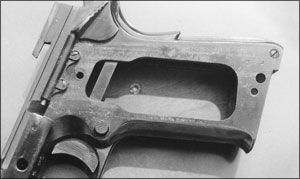
Another difference between the Llama and the 1911 is the trigger action. The trigger bar is more of a straight bar than a bow, and neither is it a system of bars and pivots as found on the Star. This makes the action unique to the Llama and eliminates the possibility of fitting Colt parts to the 9mm Llama of this generation. This is not always true, however, as I have successfully fitted Colt parts to later model Llama .45s, which are much more Colt-like.
Moving upwards, we find that the grips fully support the plunger tube as John Moses Browning intended. The plunger tube is not staked on, however. The plunger tube features an extension for screw holes and is screwed into the frame rather than staked on. Considering the plunger and the front sight, I assume the year 1911 was during “the age of staking”–a system seldom used today.
Like most of us, I’ve seen broken plunger tubes on 1911s over the years and have replaced quite a few. The Llama plunger tubes seem to work loose rather than break. I’ve examined several in need of tightening, but have not seen any that were broken.
The safety on the particular model shown here seemed tight and crisp enough, with good fitting. Doing the traditional check of the fit of the safety, I placed the safety “on,” pressed the trigger, and released the safety. The hammer did not move, the sear didn’t “click,” and the hammer did not drop. I’m certain Llama engineers thought they were improving upon the 1911 in some regards, although there is a greater possibility the slight changes had more to do with circumventing patents. The safety and grip safety were retained and work well enough.
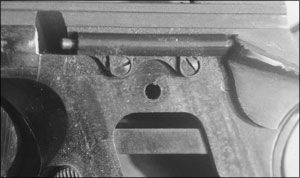
The main problem faced by anyone working with the Llama is parts. Some parts are available, but with the maker out of business, others are in short supply. The very last Llamas made are a different story, as they are much more like the standard 1911. For example, the later models accept GI magazines. The first Llamas used a magazine much more European in appearance.
Then, in the 1980s, Llamas began to appear that would take either the specially designed Llama magazine or the Colt, and finally the latest versions came with a standard GI-type magazine. The 9mm magazines have always been peculiar to the pistol, and Colt types will not work. I was fortunate to have been able to obtain a Llama 9mm magazine from Gun Parts Corporation. The original magazine had seen better days, but the one I purchased is well made of good material.
The pistol shown here worked well enough, though the owner complained of slow function. After wiping a decade or so of caked-on powder residue and crud from the piece and lubricating it liberally, I check its function with Black Hills 115-grain full metal case and 124-grain round nose. In firing 50 rounds, function was fine, with no failures to feed, chamber, fire, or eject. To test feed reliability, I keep a box of assorted hollowpoint loads that were left over from dozens of pistol tests. I found that most factory hollowpoints would not feed, and some wouldn’t even feed the first round from the magazine. Even old generation Remington hollowpoints and the proven Winchester Silvertip wouldn’t feed.
Often, these pistols don’t function because they’ve not been cleaned or lubricated. Typically, the inexpensive pistol is fed the cheapest ammunition available, often unreliable corrosive surplus or third-rate foreign-produced ammo that burns dirty and leaves considerable ash behind. Lead-bullet handloads with soft bullets are also a possible culprit.
The owner purchased the Llama as an inexpensive defense pistol–a “truck gun,” if you will–so the failure to digest loads commonly found at Wal-Mart is a problem. I gave him two options: to carefully polish and radius the feed ramp and chamber, or to order ammunition such as Cor Bon PowRBall, which is a round-nose expanding bullet that usually feeds in pistols that won’t feed anything but hard-ball FMJ. I tested a miserly amount of PowRBall–five rounds–and function was perfect, with the blast and recoil reminding me that the 100-grain bullet was traveling at 1400 fps. He elected to leave the barrel throat and polish for a later date.
As for accuracy, the pistol could be erratic. But with Black Hills ammunition, among the most consistently reliable and accurate ammunition available, results were better than what’s typical of older 9mm military pistols. The 115-grain bullet produced five-shot groups of 2-1/2 inches at 25 yards, while the 124-grain lead load went into 3 inches. This is gratifying accuracy.
Conclusions
Despite the differences between it and the Colt, when the Llama pistol stops working, it’s usually for one or more of the same reasons why a high-quality 1911 stops working: Either it’s dirty, the magazine is bad, the recoil spring is dying out, the extractor has given up, or the firing pin is broken. The plunger tube doesn’t seem to give trouble, and you’ll never have a Llama in the shop for repair of a stripped-out grip-screw bushing. The safety and hammer seem to be durable as well, and I’ve yet to see a shot-out barrel. Something else will probably give up first.
Overall, the Llama is an interesting piece of history, from a day when Spanish makers turned out tons of ironmongery along with a few excellent handguns. With an understanding of the differences in the Llama, by using the same principles used to repair the 1911, we can usually solve problems with this interesting variation on the Browning pistol.



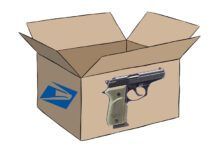
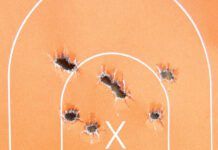













I have a LLama from the 1980’s, as a beginner then I shot less than 3 boxes of 9mm found it OK but questioned my accuracy was as poor as the targets showed and moved to another semi auto. I now think it has ages like a good wine and will try again. My preference is to trade it in along with a Star 45 I have and try to pick up a better brand in the process. would you advise selling them first or trading them given the many pitfalls you have expressed here? trading to a shop that will inspect and test before reselling it.
I have the serialnumber of a 380 LLama that I’m thinking of purchasing for $500. but I can” t find a way to run it to get the history. The serial number doesn’t have a letter in it. e.g. 07-04-2317-98. Any advice would be very much appreciated. Reuben Richardson
The author clearly doesn’t think much of the Llama pistols, and that is fine. However, he appears to contradict himself at the end. I’ll get to that.
I have several Llamas, both semiautos and revolvers. I like them all. I also have dozens of Colt and other high end 1911s as well as revolvers, including Pythons, King Cobras, 686s, etc. They ALL have advantages and disadvantages (ok, not so many disadvantages with the Python).
But first, this article has been on line for TEN YEARS. And this egregious and highly confusing error is still present, concerning the floating firing pin and whether it is present:
“If it protrudes, you do not have an inertial firing pin; if it does protrude, you do.”
So which is it? I know the answer…but this is ridiculous.
And if the pistol has had perfect function for your 50 rounds, why does the author call the Llama “indifferent to absolutely dismal” in quality, and “best suited as a beginning or entry-level pistol for the owner…who cannot afford a better piece”. Seems like it works fine. I also feel that “most were meant to be dropped on our shores among the unwary” is not only condescending, but actually libelous.
Look, it’s NOT a 1911. So the differences can NOT be called “maddening and significant”. SIGs have external extractors. Is that “maddening and significant”? Llama doesn’t call them a “1911”. So what’s the big deal?
The bottom line seems to be that the author states up front that the Llama is “utilitarian” and obviously for Noobs. However, by the end, it seems that any problems with the Llama are for “the same reasons why a high-quality 1911 stops working” (dirt, lubrication, poor ammo, hollowpoints). Accuracy is “gratifying”, even though the pistol had a decade of crud on it which had to be cleaned. The safety was “tight and crisp enough, with good fitting”. Then you have the telling “the plunger tube doesn’t seem to give trouble, and you’ll never have a Llama in the shop for repair of a stripped-out grip-screw bushing. The safety and hammer seem to be durable as well, and I’ve yet to see a shot-out barrel.”
So how often do link pins/links break? Llama decided to stake them in. So what? And an extractor which doesn’t like dry firing? So what? The plunger tube is screwed on. So what? I’d rather tighten it up than have to replace it.
We end up with the opinion that overall the Llama is an “interesting variation on the Browning pistol.” This is a FAR CRY from the introductory disgraceful statement that “the pistol can be made serviceable”! It seems to function well, with no issues, and is very accurate. That is a very result that doesn’t support the statement that it’s a “marginal handgun”.
There is a HUGE difference between facts, opinions, and recommendations. This article was clearly written by an author who went into the review with a preconceived idea…that is not supported by facts. The statement under the title says the pistol can “be challenging”. If this is a “challenge”, then bring it on! Left wing liberals would be proud of this author. I say shame on him.
I had a Llama 45acp that I carried daily for years as pp concealed carry. I put hundreds of rounds through it at the range over those years. I don’t remember I ever experienced a single issue with it the entire time I owned it. I have, however, since regretted ever parting with it and have looked to replace it with another one! I am currently looking over a 9mm version now that I have run across, and I hope to add it to my stock. I have to agree, my 45 was a real pleasure to shoot!
Drove to Atlanta and bought my Llama 9mm Largo on my 21st birthday in 1965 + a dozen boxes of old largo ammo. $35. for all. Gun store guy said it would also shoot 9mm Luger. Got luger at the pawn shop for 2 cents each. Reloads jammed but regular luger never did. Target shot maybe a thousand pinecones. Extremely accurate. When I got drafted I lovingly cleaned and secured it in the bottom of my locked chest of drawers. Returned on leave to find my brother’s friend had used my room for “study hall,” had picked the top lock and meticulously removed all five drawers to get to the pistol, which he dry-fired until he drove the firing pin deep into the chamber. I took it to an old blacksmith and said “I’m leaving for Vietnam, tomorrow. I can have somebody pick this up in a few weeks if you can do anything with it.” Blacksmith “knew a guy.” He apparently worked all night to make a new firing pin, because it was repaired, oiled and waiting for me next morning at the blacksmith’s. With a note: “No charge. Good Luck and God Be With You.” Didn’t even leave his name. never found out who it was. Blacksmith wouldn’t say except he was a patriot. I carried it to Vietnam and wore and used it on the river, preferring it to my .45. It was like a trusted old friend. Nobody can ever tell me Llamas are “Indifferent…dismal..” As a matter of decency I do not recall details, but that Llama saved my ass and others on the river one awful day. Never failed me, never missed what I aimed at….
AMEN BROTHER
I was issued a Llama 9mm in the 1970s in an African country that no longer exists. Worked fine. Fired a lot of rounds through it. Heavy for the mag capacity but better than the Tokarev that was the only other option.
Everything I have seen only referenced Stars in that particular conflict but I am sure it was a LLama
Great story. I own a llama 9mm parrabellum I bought it at a gun shop. I cleaned it up good and it shoots great. I bought some taures magazines by mecgar and they work perfect. I really like my llama 9 parrabellum.
I owned a llama .9mm para bellum. It used to work great until I lost 1 part of its shell extracting system. Now I find it hard to buy a replacement part..